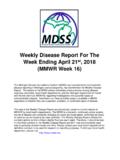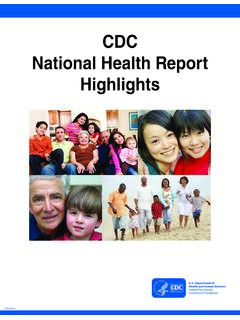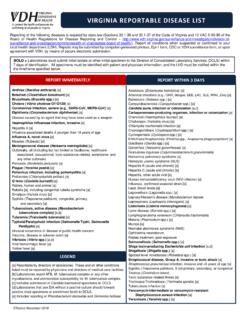Transcription of Diseases Transmitted through the Food Supply
1 DEPARTMENT OF HEALTH AND HUMAN SERVICES Centers for Disease Control and Prevention Diseases Transmitted through the Food Supply AGENCY: Centers for Disease Control and Prevention (CDC), Department of Health and Human Services (HHS).
2 ACTION: Notice of annual update of list of infectious and communicable Diseases that are Transmitted through handling the food Supply and the methods by which such Diseases are Transmitted . SUMMARY: Section 103 (d) of the Americans with Disabilities Act of 1990, Public Law 101 336, requires the Secretary to publish a list of infectious and communicable Diseases that are Transmitted through handling the food Supply and to review and update the list annually. The Centers for Disease Control and Prevention (CDC) published a final list on August 16, 1991 (56 FR40897) and updates on September 8, 1992 (57 FR 40917); January 13, 1994 (59 FR 1949); August 15, 1996 (61 FR 42426); September 22, 1997 (62 FR 49518 9); September 15, 1998 (63 FR 49359); September 21, 1999 (64 FR 51127); September 27, 2000 (65 FR 58088); September 10, 2001 (66 FR 47030); September 27, 2002 (67 FR 61109); September 26, 2006 (71 FR 56152); November 17, 2008 (73 FR 67871); and November 29, 2009 (74 FR 61151).
3 The final list has been reviewed in light of new information and has been revised as set forth below. DATES: Effective Date: January 31, 2014. FOR FURTHER INFORMATION CONTACT: Dr. Art Liang, Division of foodborne Waterborne and Environment Diseases , National Center for Emerging and Zoonotic Infectious Diseases , Centers for Disease Control and Prevention (CDC), 1600 Clifton Road, NE., Mailstop G 24, Atlanta, Georgia 30333. Telephone: (404) 639 2213. SUPPLEMENTARY INFORMATION: Section 103 (d) of the Americans with Disabilities Act of 1990, 42 12113 (d), requires the Secretary of Health and Human Services to: 1. Review all infectious and communicable Diseases which may be Transmitted through handling the food Supply ; 2. Publish a list of infectious and communicable Diseases which are Transmitted through handling the food Supply ; 3.
4 Publish the methods by which such Diseases are Transmitted ; and, 4. Widely disseminate such information regarding the list of Diseases and their modes of transmissibility to the general public. Additionally, the list is to be updated annually. Since the last publication of the list on September 26, 2006 (67 FR 61109), no information has been added. Pathogens Transmitted by Food Contaminated by Infected Persons Who Handle Food.
5 And Modes of Transmission of Such Pathogens Some pathogens are frequently Transmitted by food contaminated by infected persons. The presence of any one of the following signs or symptoms in persons who handle food may indicate infection by a pathogen that could be Transmitted to others through handling the food Supply : diarrhea, vomiting, open skin sores, boils, fever, dark urine, or jaundice. The failure of food-handlers to wash hands in certain situations (such as after using the toilet, handling raw meat, cleaning spills, or carrying garbage), wear clean gloves, or use clean utensils is responsible for the foodborne transmission of these pathogens. Non- foodborne routes of transmission, such as from one person to another, are also major contributors in the spread of these pathogens.
6 Some pathogens usually cause disease when food is intrinsically contaminated or cross-contaminated during production, processing or transportation, but may also be contaminated when prepared by infected persons. Bacterial pathogens in this category often cause disease after bacteria have multiplied in food after it has been kept at improper temperatures permitting their multiplication to an infectious dose. Preventing food contact by persons who have an acute diarrheal illness will decrease the risk of transmitting these pathogens. The following represent both types of pathogens that may be Transmitted by an infected food handler: Astroviruses Bacillus cereus Campylobacter jejuni Clostridium perfringens Cryptosporidium species Entamoeba histolytica Shiga toxin-producing E.
7 Coli Enterotoxigenic E. coli Giardia intestinalis Hepatitis A virus Nontyphoidal Salmonella Noroviruses Rotaviruses Salmonella Typhi* Sapoviruses Shigella species Staphylococcus aureus Streptococcus pyogenes Taenia solium - cysticercosis Vibrio cholera Yersinia enterocolitica
8 References 1. World Health Organization. Health surveillance and management procedures for food-handling personnel: report of a WHO consultation. World Health Organization technical report series; 785. Geneva: World Health Organization, 1989. 2. Marshal DL, Dickson JS. Ensuring food safety. In: Last JM, ed. Maxcy-Rosenau public health and preventive medicine. 15th edition. McGraw-Hill Medical; 2007:847 863. 3. Bennett JV, Holmberg SD, Rogers MF, Solomon SL. Infectious and parasitic Diseases . In: Amler RW, Dull HB, eds. Closing the gap: the burden of unnecessary illness .
9 New York: Oxford University Press; 1987:102 114. 4. Centers for Disease Control and Prevention. Locally acquired neurocysticercosis North Carolina, Massachusetts, and South Carolina, 1989 1991. MMWR Morb Mortal Wkly Rep 1992;41:1 4. 5. Centers for Disease Control and Prevention. foodborne outbreak of cryptosporidiosis Spokane, Washington, 1997. MMWR Morb Mortal Wkly Rep 1998;47:27. 6. Hall AJ, Lopman BA, Vinj J. Sapovirus. In: Morris JG, Jr., Potter M, eds. foodborne infections and intoxications. 4th ed. In Press. 7. Centers for Disease Control and Prevention. Surveillance for foodborne disease outbreaks --- United States, 2008. MMWR Morb Mortal Wkly Rep 2011;60(35):1197-1202. 8. Hall AJ, Eisenbart VG, Lehman Eting e A, Gould LH, Lopman BA, Parashar UD.
10 Epidemiology of foodborne norovirus outbreaks, United States, 2001 2008. Emerg Infect Dis 2012; 17(10):1566-1573. 9. Greig JD, Todd EC, Bartleson CA, Michaels BS. Outbreaks where food workers have been implicated in the spread of foodborne disease. Part 1. Description of the problem, methods, and agents involved. J Food Prot 2007;70(7):1752-1761. 10. Scallan E, Hoekstra RM, Angulo FJ, et al. foodborne illness acquired in the United States---major pathogens. Emerg Infect Dis 2011;17(1):7-15. Dated: November 16, 2009. 11. Lynch M, Painter J, Woodruff R, Braden C. Surveillance for foodborne -disease outbreaks United States, 1998 2002. MMWR Morb Mortal Wkly Rep 2006;55:1 34. 12. Food and Drug Administration. FDA report on the occurrence of foodborne illness risk factors in selected institutional foodservice, restaurant, and retail food store facility types (2009).














